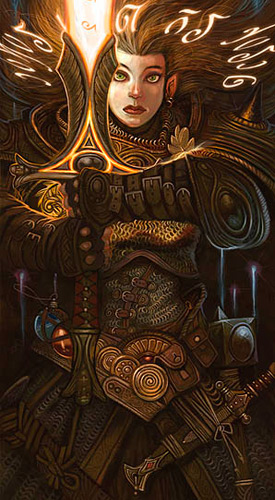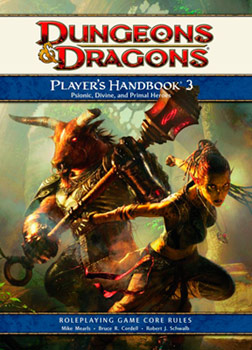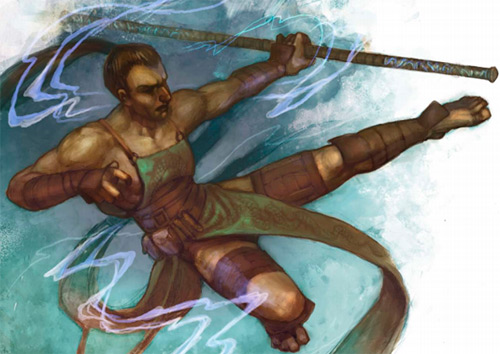Review: Player’s Handbook 3; Part 1: The Psionic Power Source
Player’s Handbook 3: Psionic, Divine and Primal Heroes will be out in North American stores day after tomorrow, and I have recorded my impressions of this third set of races, classes and character options for players. As usual, the book is gorgeous, featuring some great art from William O’Connor who does the splash art for the new classes, and Adam Gillespie handling the same duties for the new races. Our recently named favorite Eva Widermann has a few pieces in here too, but she’s outnumbered by other artists like Jason Engle. Between Engle and PHB2’s Steve Argyle, the art in these books are taking a turn for the hyper-realist, as is evidenced by the cover by Michael Komarck.
The book is misleadingly named, as only one new class is introduced for the Divine and Primal power source each. Instead, the focus is clearly on the Psionic power source, which introduces four new classes to the table: The Ardent, a leader who uses psionic magic to psychically influence the tide of battle; the Battlemind, whose psionics allow him to gain the tactical advantage that a defender requires; the Monk, a striker who uses harnesses psionic power to achieve total mobility and the Psion, a controller who brings down her foes through telekinetic assaults or psychic attacks. WotC has made each class distinct from one another and distinct from prior classes, so any worries that this third set of classes would be the X-3: Last Stand of the PHBs can be put to rest.
The first thing you should know about the Psionic classes is that they introduce several new mechanics. The Psion, Ardent and Battlemind make use of power points – the quantity of which depends on a character’s level and is replenished after a short or extended rest – to augment their psionic powers, and have no encounter powers to speak of, save for some utility powers. Instead, they have a host of at-wills that can be boosted by these power points. For example, a Level 7 at-will called Ego Crush, allows a Battlemind to deal 1[W] + Constitution damage, and denies his target the ability to gain combat advantage until the end of his next turn. When boosted, it can be used as an opportunity attack or when maxed out, deals double damage against each enemy within a close burst. Yowza!
 The Ardent’s presence on the field confers an empathic benefit, making her comparable to the Warlord. This doesn’t mean that she’s identical in play or flavor. For example, a Euphoric Ardent build uses her scarcely contained emotions to stir her allies, effectively giving bonuses to Diplomacy and Intimidate to them while increasing opportunity attack damage. A relevant power would be Forward Thinking Cut, which complements a charge attack and when augmented, allows her allies to charge as a free action with a damage bonus equal to her Consitution bonus. By contrast, an Enlightened Ardent boosts Insight & Perception and defences against opportunity attacks and exudes a calm leader aura, suited to powers like Prescient Strike, which sets up the opportunity to inflict a penalty on an attack roll against an ally.
The Ardent’s presence on the field confers an empathic benefit, making her comparable to the Warlord. This doesn’t mean that she’s identical in play or flavor. For example, a Euphoric Ardent build uses her scarcely contained emotions to stir her allies, effectively giving bonuses to Diplomacy and Intimidate to them while increasing opportunity attack damage. A relevant power would be Forward Thinking Cut, which complements a charge attack and when augmented, allows her allies to charge as a free action with a damage bonus equal to her Consitution bonus. By contrast, an Enlightened Ardent boosts Insight & Perception and defences against opportunity attacks and exudes a calm leader aura, suited to powers like Prescient Strike, which sets up the opportunity to inflict a penalty on an attack roll against an ally.
The Battlemind is probably going to be poster boy for those who believe that 4th Edition is undergoing power creep, as it is easily one of the best defender classes. Not as mobility/reach dependent as the Warden or complicated as the Swordmage, the Battlemind uses a minor action to mark a creature within a close burst 3. However, the mark punishment requires the creature to actually deal damage for the Battlemind to punish him. That means that a Battlemind can only put the hurt on marks that successfully deal hurt, whereas other defenders punish marks who simply think about looking the other way. Still, his mark punishment, Mind Spike, deals damage equal to the damage a mark deals, ergo psychic feedback! Powers such as Mist Weapon, which allows him to handle insubstantial enemies while Psionic Speed and Lightning Rush allow him to reacquire defender superiority.
 How a Psion plays differs much more along build than most other classes. One that focuses on telepathic powers such as Id Insinuation and Mind Break will soften up enemies for her allies, while exercising versatility in the form of various mind control effects. One that focuses on telekinetic powers will find great synergy with others by moving foes back into the threat range of less mobile defenders or into the damage zones of other controllers. The only problem is that relying on either psychic damage or force damage leaves a Psion less effective against creatures with high levels of mobility or strong Will defences and more effective when working with friends. Which is what 4th Edition is supposed to be about, so that’s good.
How a Psion plays differs much more along build than most other classes. One that focuses on telepathic powers such as Id Insinuation and Mind Break will soften up enemies for her allies, while exercising versatility in the form of various mind control effects. One that focuses on telekinetic powers will find great synergy with others by moving foes back into the threat range of less mobile defenders or into the damage zones of other controllers. The only problem is that relying on either psychic damage or force damage leaves a Psion less effective against creatures with high levels of mobility or strong Will defences and more effective when working with friends. Which is what 4th Edition is supposed to be about, so that’s good.
The only Psionic class that does not use power points to augment his abilities is the Monk. Instead his powers are known as disciplines and many of them give the option to incorporate a special maneuver at the cost of a move action, allowing him to have a diverse means of getting around the battlefield to strike at important targets. For example, the encounter power Drunken Monkey allows him to move at speed + 2 while ignoring difficult terrain and gain a Wisdom bonus to defense against opportunity attacks. Oh, and he deals a modest amount of damage while forcing the target to attack another enemy. Wicked. Best of all, many of his powers such as the level 3 encounter power Twin Thunders – which deals a total of 3d10 worth of damage against two targets – go for Fortitude or Reflex, which in most cases, is better than targeting AC.
All in all, the Psionic classes are exciting new choices for players. My only real misgiving is that it continues the trend in 4th Edition towards more book keeping. Between healing surges, daily item powers, encounter powers and daily powers and class features, there are already plenty of exhaustible resources to track without adding power points into the mix. Granted, previous editions had a disproportionate balance of resource tracking: fighters worried about little more than their next attack while wizards fumbled through reams of paper and post-it marked rulebooks to track casting times and mark spells to learn and memorize. Still, the Psionic classes are probably recommended for more experienced players. Thankfully, they aren’t just designed to be exotic for the sake of it, and are great additions to the game.
Tune in to the next time where we’ll talk about the Runepriest, the Seeker, Skill Powers, the new races and the Hybrid class options. Not necessarily in that order.
Other reviews of Player’s Handbook 3 by friends of My Girlfriend is a DM:
If you enjoyed this post, kindly consider purchasing Player’s Handbook 3: Psionic, Divine and Primal Heroes as well as any number of 4th Edition D&D products from Amazon.com
Comments
6 Responses to “Review: Player’s Handbook 3; Part 1: The Psionic Power Source”Trackbacks
Check out what others are saying...-
[…] D&D, D&D4e, Fluff, Review and Uncategorized Tags: 4e, d&d, optimization, roleplay In the first installment of my review of Player’s Handbook 3, I took a deep look at the classes introduced by the Psionic power […]
-
[…] installments of our in-depth look at Player’s Handbook 3, we looked at the new races, and the classes for the new psionic power source. The classes introduce new mechanics that may suit them better for experienced players, but are […]
-
[…] This is the final part of our multi-post look at Player’s Handbook 3. In previous installments, we took a look at the debut classes for the new psionic power source, which introduced some interesting and exciting mechanics, some of which are more suited for […]
-
[…] is the final part of our multi-post look at Player’s Handbook 3. In previous installments, we took a look at the debut classes for the new psionic power source, which introduced some interesting and exciting mechanics, some of which are more suited for […]
-
[…] In the first installment of my review of Player’s Handbook 3, I took a deep look at the classes introduced by the Psionic power source. They’ve all turned out to be pretty exciting classes to play, but with some quirks that may make them suited for more experienced players. I don’t think I mentioned this, but most of my thoughts are based on how they would play in the heroic tier, and it remains to be seen how they will scale in the paragon and epic tier. Today, we’re going to look at the new races, all of which seem to be of the exotic variety that may appeal to those who have tired of dwarves, elves and gnomes. […]





I am keenly interested in stuff like telekinesis and do my best if the practice will be made clear to me
thanks